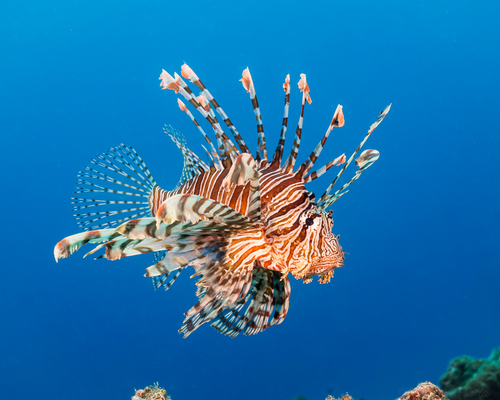
Red Lionfish
The Atlantic bluefin tuna (Thunnus thynnus) is a majestic and powerful fish, renowned for its size, speed, and commercial value. As one of the largest bony fish, it plays a critical role in the marine ecosystem and has been a prized catch for centuries. This magnificent species faces significant conservation challenges.
5 10 years
Lifespan
30 - 45 cm
Length
Least Concern
Conservation Status
15 km/h
Swimming speed
Carnivorous
Diet
Local Migration
Migration
Appearance Overview
The Atlantic bluefin tuna is a large, pelagic fish with a streamlined, torpedo-shaped body built for speed and endurance.
Color
Dark metallic blue on top, silvery-white on the bottom
Fins
Two dorsal fins, the first is depressible; a series of small finlets run from the second dorsal and anal fins to the tail
Body shape
Torpedo-shaped and streamlined
Length
Up to 13 feet (4 meters)
Weight
Up to 2,000 lbs (907 kg)
Diet
Carnivorous, feeding on smaller fish (like mackerel, herring, and sardines), squid, crustaceans, and eels.
Feeding Behavior
They are opportunistic predators, using their speed and agility to hunt. They can also filter-feed on smaller organisms. Bluefin tuna often hunt cooperatively, herding prey into tight formations.
Social Behavior
Highly migratory, forming large schools, especially when young. Schools are often segregated by size, and sometimes by sex. They can exhibit complex social behaviors, including cooperative hunting.
Commercial Relevance
Extremely high value, especially in the sushi and sashimi markets. A single fish can be sold for thousands, even hundreds of thousands of dollars, depending on its size and quality.
Conservation measures
International fishing quotas, minimum size limits, time-area closures, and efforts to reduce bycatch. Monitoring of populations and enforcement of regulations are ongoing.
Status
Varies by population; the Atlantic population is considered overfished, with some stocks classified as endangered or critically endangered.
Threats
Overfishing (historically and currently), bycatch in fishing gear, climate change (affecting prey distribution and spawning grounds), and habitat degradation.
Habitat Distribution
Depth Range
0-1,000 meters (0-3,280 feet), with a preference for shallower waters in certain seasons.
Geographic Range
Found throughout the North Atlantic Ocean, including the Mediterranean Sea. Historically, their range extended to the Black Sea.
Preferred Environment
Temperate and subtropical waters; pelagic (open ocean) environments. They undertake long migrations across ocean basins.
Reproduction and Life Cycle
Breeding Habits
Spawns in warm waters, primarily in the Mediterranean Sea and the Gulf of Mexico. Spawning occurs from spring to summer, with specific timing varying by location.
Development Stages
Eggs are released and fertilized in the water column. Larvae are planktonic, feeding and growing rapidly. Juveniles form schools and gradually move to different feeding grounds.
Fecundity
Highly fecund; a single female can release up to 30 million eggs per spawning season.
Maturity Age
Maturity varies by location; Mediterranean populations mature around 4-5 years, while western Atlantic populations may mature at 8-12 years.
Faqs about Red Lionfish
Can I eat Atlantic bluefin tuna?
Yes, but it's crucial to choose sustainably sourced bluefin tuna. Check for certifications and recommendations from reputable organizations like the Marine Stewardship Council (MSC) or the Monterey Bay Aquarium Seafood Watch.
Are bluefin tuna warm-blooded?
Bluefin tuna are endothermic, meaning they can regulate their body temperature. This allows them to hunt in colder waters and gives them an advantage in pursuing prey.
How long do Atlantic bluefin tuna live?
Atlantic bluefin tuna can live up to 40 years, although the average lifespan is likely shorter due to fishing pressure.
How fast can Atlantic bluefin tuna swim?
Atlantic bluefin tuna are among the fastest fish in the ocean, capable of reaching speeds up to 40-60 mph in short bursts.
Do bluefin tuna always stay in deep water?
While they can dive deep, they also spend time near the surface, especially when feeding or migrating.
Copyright @ Nature Style Limited. All Rights Reserved.
 English
English